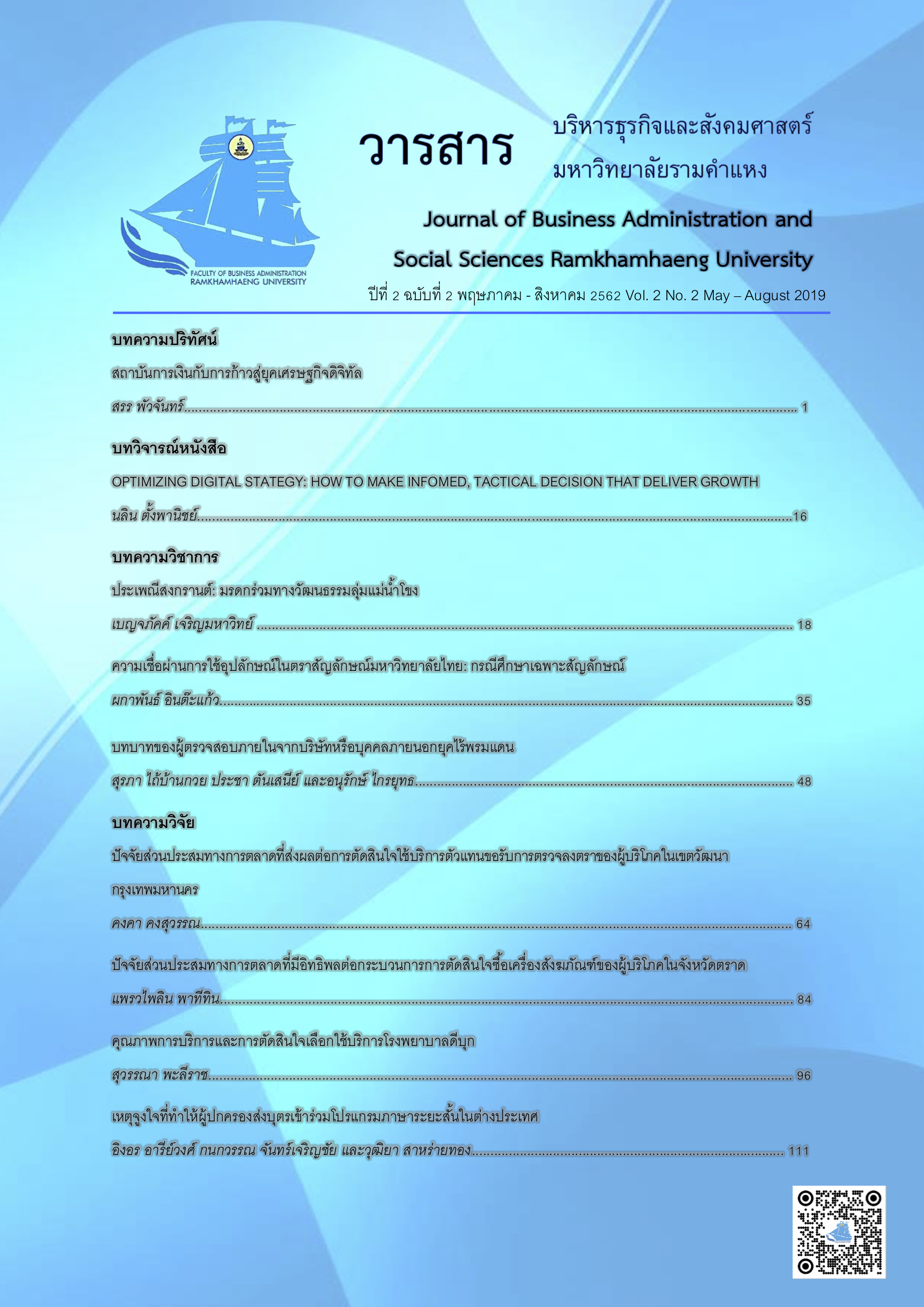PARENTS’ MOTIVES FOR SENDING CHILDREN TO JOIN SHORT LANGUAGE PROGRAMS ABROAD
Main Article Content
Abstract
The awareness on the importance of foreign language communication in Thailand has increased over the years, resulting in the rapid growth of businesses supporting education. However, the existence of these related businesses tends to decrease, leading up to the question of how these businesses can continue to exist and remain relevant.
A study on demand and factors influencing the probability in joining foreign language programs abroad is one way to promote business survival. The issues to be considered are marketing mix affecting the business of educational services and the fostering of an opportunity for parents to send their children at Matthayom Sueksa One to Matthayom Sueksa Six level in Bangkok Metropolis to join short language programs abroad.
The sample population consisted of 415 parents. The t test and F-test techniques were applied to test the differences of means and the variance of attention paid to the marketing mix between the members of the sample population in an overall comparative manner. The findings showed that differences were not found at a statistically significant level, except for physical factor. The marginal effect affecting the decision to join language programs abroad was obtained from the logistics analysis. The findings showed that marketing mix in the aspect of prior to and after sale procedures with the consideration of information access and safety of participants in language programs abroad exhibited the relationship with the aspect of sales representatives. The company had an efficient system of sales training. Meanwhile, parents with an experience of studying abroad exhibited differences in their tendency to send their children abroad to join the language programs from the parents who used to work in foreign countries. In addition, a three- to four- week program was appropriate for joining the programs because the expenses were not too high. This was in consonance with the level of household income.
Article Details
เนื้อหาและข้อมูลในบทความที่ลงตีพิมพ์ในวารสารบริหารธุรกิจและสังคมศาสตร์ มหาวิทยาลัยรามคำแหง ถือเป็นข้อคิดเห็นและความรับผิดชอบของผู้เขียนบทความโดยตรง ซึ่งกองบรรณาธิการไม่จำเป็นต้องเห็นด้วย หรือร่วมรับผิดชอบใดๆ
บทความ ข้อมูล เนื้อหา รูปภาพ ฯลฯ ที่ได้รับการตีพิมพ์ในวารสารบริหารธุรกิจและสังคมศาสตร์ มหาวิทยาลัยรามคำแหง ถือเป็นลิขสิทธิ์ของวารสารบริหารธุรกิจและสังคมศาสตร์ มหาวิทยาลัยรามคำแหง หากบุคคลหรือหน่วยงานใดต้องการนำบทความทั้งหมดหรือส่วนหนึ่งส่วนใดไปเผยแพร่ต่อ หรือเพื่อกระทำการใดๆ จะต้องได้รับอนุญาตเป็นลายลักษณ์อักษรจากวารสารบริหารธุรกิจและสังคมศาสตร์ มหาวิทยาลัยรามคำแหง ก่อนเท่านั้น
References
กระทรวงพาณิชย์, กรมพัฒนาการค้า. (2562). ภาพรวมธุรกิจการเรียนการสอนภาษา. สืบค้นเมื่อ 3 พฤษภาคม 2562, จาก http://datawarehouse.dbd.go.th/forecast/revenue/85500
ทิพย์ธิดา สกุลทองอร่าม. (2557). ปัจจัยการไปศึกษาต่อต่างประเทศของนักเรียนชาวเกาหลี ตั้งแต่ปี 1990 ถึง 2012. วิทยานิพนธ์ศิลปศาสตรมหาบัณฑิต, จุฬาลงกรณ์มหาวิทยาลัย.
ฮิโรนากะ โทมิตะ และทาโร โมจิซึคิ. (2559). ความต้องการศึกษาต่อประเทศญี่ปุ่นของนักศึกษาชาวไทยและนโยบายรัฐบาลญี่ปุ่นในการรับนักศึกษาต่างชาติ. วารสารเครือข่ายญี่ปุ่นศึกษา, 6(1), 131-146.
Gordon, P., Heischmidt, K., Sterrett, J., & McMillan, H. (2009). Internationalising the business program: One college‘s approach. Presented at the Marketing Management Association Fall Educator’s Conference. Retrieved May 5, 2019, from https://www.researchgate.net/.publication/259864511_INTERNATIONALIZING _THE_BUSINESS_PROGRAM_ONE_COLLEGE'S_APPROACH.
Chieffo, L., & Griffiths, L. (2004). Large-scale assessment of student attitudes after a short-term study abroad program. The Interdisciplinary Journal of Study Abroad, 10(1), 165-177.
Cochran, W. G. (1963). Sampling Techniques (2nd ed.). New York: John Wiley and Sons.
Lewis, T. L., & Niesenbaum, R. A. (2005). Extending the stay: Using community-based research and service learning to enhance short-term study abroad. Journal of Studies International Education, 9(3), 251-264.
Long, S., Akande, Y., Purdy, R., & Nakano, K. (2010). Deepening learning and inspiring rigor: Bridging academic and experiential learning using a host country approach to a study tour. Journal of Studies in International Education, 14(1), 89-111.
Paula, M., Emanuela, R., & Avram, M. (2003). Optimizing the marketing mix: An essential element in developing competitive strategies in the field of higher education. Romanian Economics and Business Review, 8(1), 57-65.
Sachau, D., Neil B., & Scott, F. (2009). Three models for short-term study abroad. Journal of Management Education, 34(5), 645-670.


